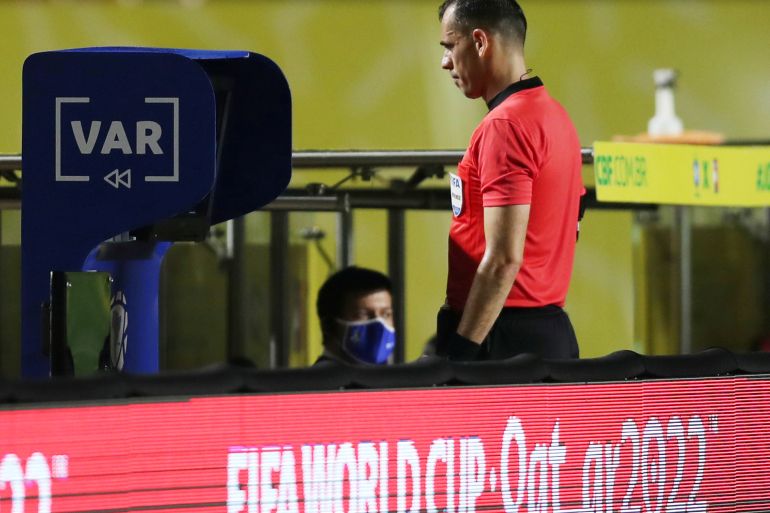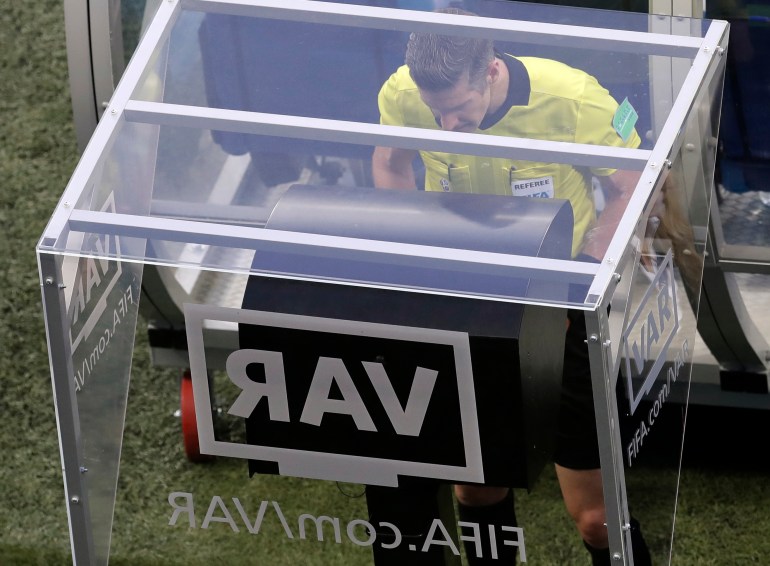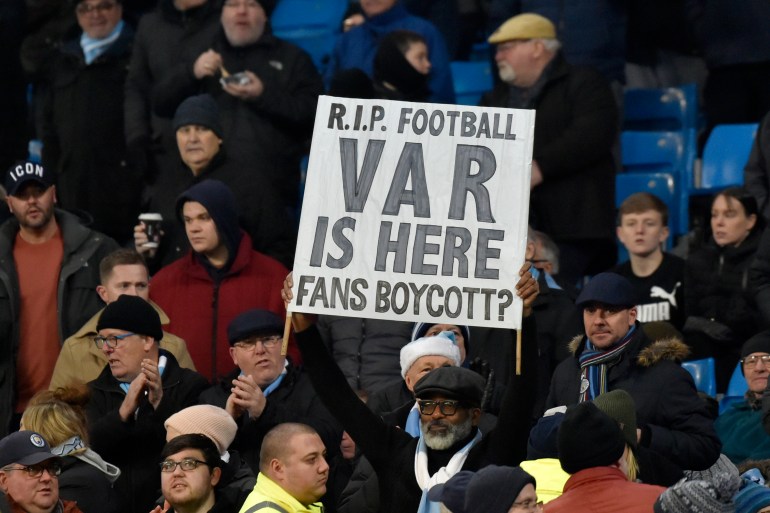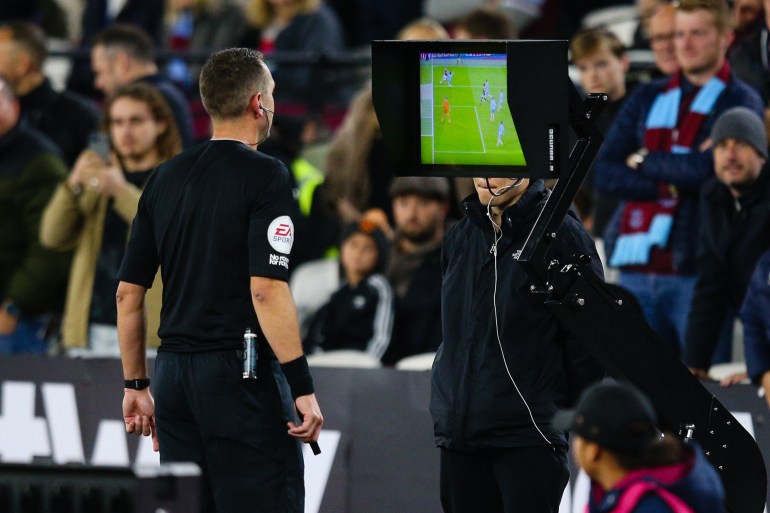Is VAR the villain of the World Cup?
Love it or hate it, the video assistant referee is here to stay – so what does it mean for the game?

If you’re not already familiar with VAR, or video assistant referee, during the 2022 World Cup you’re about to become very familiar with it. Refereeing with video replay can mean overturning goals, ejecting players, and plenty of moans and cheers. This time, VAR is back with semi-automation to determine if players are offside, with cameras and sensors tracking every limb on the pitch. When it was introduced for the first time at a World Cup in 2018, it changed the tournament – with passionate disagreement about whether that was for better or for worse. So what does VAR have in store for this World Cup?
Keep reading
list of 3 itemsA football player’s journey from Mali to Belgium
Qatar’s World Cup, from the inside out
In this episode:
- Tony Karon (@TonyKaron), editorial lead at AJ+
- Abdulla Al-Marri (@Referee_Qtr), World Cup video assistant referee
Connect with us:
@AJEPodcasts on Twitter, Instagram, and Facebook
Full episode transcript:
This transcript was created using AI. It’s been reviewed by humans, but it might contain errors. Please let us know if you have any corrections or questions, our email is TheTake@aljazeera.net.
Halla Mohieddeen: The World Cup starts Sunday with a long list of famous names, from Messi to Cristiano Ronaldo to Neymar. But there’s one more big name off the pitch that you already either know well, or you’re about to become very familiar with. Video assistant referee. V-A-R. Or, simply just VAR.
Newsreel: VAR’s a load of rubbish.
Newsreel: Wa hakim al VAR. Lagha al hadaf.
Newsreel: Por primera vez en la historia del fútbol, ¡aplauden gracias a Dios al VAR!
Halla Mohieddeen: When FIFA, the World Cup’s governing body, introduced VAR in 2018, it changed the tournament. Four years on, the debate hasn’t died down – and this year, there will be new technology in the mix. Love it or hate it, VAR is here to stay. So what does that mean for the game? I’m Halla Mohieddeen and this is the Take.
[THEME MUSIC PLAYING]
Halla Mohieddeen: I’m talking again with our own Tony Karon, the editorial lead of Al Jazeera’s AJ Plus. And then we’ll take some of those questions around VAR and pose them to an actual World Cup assistant referee in Qatar.
Tony Karon: I’m Tony Karon. I have been immersed in this game for the best part of four plus decades, and I have taught graduate classes at the New School in New York on the politics of global football.
[MUSIC PLAYING]
Halla Mohieddeen: Let’s start off with the basics then. Who or what is VAR?
Tony Karon: Video assistant refereeing is a system that provides backup, shall we say to replay incidents where there’s some controversy.
Newsreel: The referee can delay the restart of play at any time to communicate with the VAR team and will signal this by pointing to his ear.
Tony Karon: There’s a panel of referees external to the game who review this on the video.
Newsreel: Once the VARs or the referee decide an incident is, in fact, reviewable, the referee would initiate an official review by signalling the outline of a TV screen.
Tony Karon: The referee’s invited to you know, go and look at a pitchside monitor and potentially change a decision.
Halla Mohieddeen: Let’s talk about the reception from supporters. Tony, you’re a fan yourself. Tell me how you felt about VAR the first season you watched it play out.
Tony Karon: I mean, it’s the most frustrating thing for a fan because, you know, you think about a game of football, it’s 90 minutes of stress and tension. Usually punctuated. If you are lucky by the occasional moment of release in that your team scores or comes very close to scoring, you know, your forward – he gets on the end of that cross, you’re like, how did he even get there? And my gosh, he’s done that with the outside of his heel. It’s extraordinary and you’re just on your feet and you are screaming, you’re roaring. And now in the game, somebody scores and there’s that moment, but it’s kind of cut short because every goal these days is checked by VAR.

[MUSIC PLAYING]
Tony Karon: So there’s anything, you know, between 10 seconds and a minute and a half before that goal is awarded. After which there’s a much more muted celebration. I mean, literally, you can have moments where the players are waiting so long for the VAR check that the players find themselves having to do warm-up exercises just to keep their muscles from cramping up. In terms of the emotional experience of watching a game and feeling a game, VAR is really just a mood killer.
[MUSIC PLAYING]
Halla Mohieddeen: In England, where the Premier League has had a famously rocky rollout of VAR, a major survey found more than 90 percent of fans saying it made watching matches less enjoyable. So why introduce it at all?
Tony Karon: Well, how much time have you got? There’s incident after incident, but one of the clearest cases came in the run-up to the 2010 World Cup. It was a qualifying match between Ireland and France, during the heyday of French striker Thierry Henry.
Newsreel: The game had been going well for Ireland. Robbie Keane levelling the World Cup qualifying tie to send the match into extra time. Game on!
Halla Mohieddeen: Then, in the 103rd minute, Henry scored for France.
Newsreel: It’s in the net. It’s a goal.
Halla Mohieddeen: But on camera, you can clearly see Henry’s hand cupping the bottom of the ball.
Newsreel: Oh dear. Oh dear. That’s a handball twice by Thierry Henry. Look at that.
Newsreel: The Irish players are appealing for a handball here.
Newsreel: The goal counts.
Newsreel: The referees made his decision. He’s given the goal.
Halla Mohieddeen: It was clear as day on TV, but on the pitch, the referees missed it. The goal stood, Ireland missed the World Cup, and the clamour for VAR got even louder. For the 2018 World Cup, to FIFA, the technology was a no-brainer. This is FIFA President Gianni Infantino.
Gianni Infantino: Without the VAR, a referee commits an important mistake, a huge mistake every three matches. With the VAR, the referee commits an important mistake every 19 matches. Those are facts.
Halla Mohieddeen: Tony says the need comes from the pace of the modern game.
Tony Karon: The speed at which the game is played right now is incredible, you know, to the human eye, the speed at which things happen. Balls won in the tackle, tackles fouls for the human eye to record all of that and assess it. And that’s really the key point, assessing it is quite an ask. So you can see many reasons why, you know, a history of bad calls has prompted the idea of you can provide a perfect set of visual facts to a referee by using technology. And the idea that it will make the game more fair. It will reduce the dissatisfaction of fans and any suspicion of, sort of, foul play. That’s the theory. There are some interesting things to say about how that’s worked in practice.
[MUSIC PLAYING]
Halla Mohieddeen: Just for starters, how to use VAR is up to the match referee. VAR is a tool that’s available, but the referee makes the final call on whether or not to go with it, and how long to spend looking at the monitor. The referee might not go to the monitor when it is needed, or occasionally, he might be influenced by VAR to change his decision when he was actually right in the first place. That inconsistency is what led to accusations in 2018 from fans that VAR decisions were favouring the big teams in Europe and Latin America. Morocco, Iran, Nigeria, Serbia – all felt strongly that there were huge moments that ended up hurting them. Aside from questions of bias, there’s also just the nature of trying to pinpoint on video a game that’s happening at high speed. Sometimes there isn’t a single snapshot that clarifies everything.
Tony Karon: What’s happening is, and I mean this is, you know, this is not even a controversial thing to say, is that many decisions that are made using VAR technology turn out to have been wrong. In other words, the refs sitting in the VAR booth have made the wrong call.
Halla Mohieddeen: There seems to be lots of examples, Tony, which begs the question from my part. You know, crickets used it for years. Rugby’s used it for years without the level of controversy there is in football. It just seems to be that the only sport that has a real problem with VAR seems to be football.
Tony Karon: Yes and no. What VAR does is provides a perfect set of visual facts which have to be interpreted by a referee. And the referee then has to weigh the meaning of this fact, that fact, and then the fact that followed to weigh the importance to the outcome of each of those facts, to relate them to a set of multiple different rules. It’s like, you know, Richarlison’s hand was on Conarte’s shoulder. Well, how significant was that hand on the shoulder? The visual evidence is there, but the ref is gonna have to make a decision about how did that affect the outcome.

[MUSIC PLAYING]
Tony Karon: So, the idea that you provide a perfect set of visual facts that’s going to ensure perfect refereeing is just a fallacy. In fact, if anything, what that’s going to highlight are gonna be the flaws because the audience, the crowd, the TV viewer is going to see exactly what the referee saw and going he saw that and he still, you know, didn’t give a foul. Like, that’s insane. That’s literally where we are right now.
Halla Mohieddeen: So the problem’s not VAR. The problem is referees.
Tony Karon: Yeah. The problem is human refereeing.
[MUSIC PLAYING]
Halla Mohieddeen: That’s one reason why this World Cup will be the first for another new technology: semi-automation. It’s going to be used to determine offside. A quick recap of the offside rule: Without offside, a player could just stand next to the opponent’s goal the whole game if he wanted, just waiting for a lucky pass from the other end of the pitch. Offside is the reason teams have to actually move the ball down the field, player to player, box to box.
Newsreel: According to FIFA, a player is in an offside position if he is nearer to his opponent’s goal line than both the ball and the second-last opponent.
Halla Mohieddeen: That means the referee needs to judge the ball, the player, and the opponents – all at the same time.
Tony Karon: Flagging something for offside literally requires the human eye to be pointed in two opposite directions at once. The place where the ball is being kicked and to the line of players who might be running onto that ball.
Halla Mohieddeen: The easiest way to judge it? Slap a line down the screen, and run it in slow motion, looking for a shoulder or an ankle to stick out. Problem is, picking out one limb from a big group of moving players can take a long time.
Tony Karon: The new system is going to take that out of the hands of the referees.
Newsreel: Twelve dedicated tracking cameras mounted underneath the roof of each stadium, track the ball, and 29 points on the body of each individual player, 50 times per second, calculating their exact position on the pitch. Then, with an offsite decision comes along, image processing algorithms can provide a clear picture of events almost immediately.
Halla Mohieddeen: The call is still up to the officials, but they’ll get, we’re told, a much more accurate picture.
[MUSIC PLAYING]
Tony Karon: Now, what that will do is speed it up immensely, right? So, you know, I’ve seen it, when you see it rendered on screen. It’s kind of like these weird bubble figures. It’s not, at least on the video screen, you see the player, whatever, not some sort of robotic bubble representation of the player. But, you know, put that aside. So then if any part of the body is across the line, that AI will immediately flag it. So that will happen a lot quicker than referees being forced to, you know, scrutinise a screen and make a call.
Halla Mohieddeen: Now, Tony, you’ve just finished telling us that no matter how much technology you have, the answer still comes down to humans at the end of the day. So is the answer removing humans from the equation? Is more tech the answer?
Tony Karon: Not necessarily. It can be absolutely, you know, to the letter. But it sort of starts to violate the spirit, still, you know, on balance. You can say, OK, offside, you can automate and it will produce some absurd calls, but it will be quicker. You’ll know the outcome much quicker.
Halla Mohieddeen: After the break, we call up a referee ourselves to get his side of the story. That’s in a moment.
Abdulla al-Marri: My name is Abdulla al-Marri. I’m a Qatari referee. I’m from Qatar. I love sport and that’s why I’m here tonight.
Halla Mohieddeen: Abdulla’s only 29, but he’s already refereed at the Tokyo Olympics and the Asian Football Confederation Cup. So when I asked Abdulla if he’s ready for the pressure of a World Cup. He said it’s all part of the game.
Halla Mohieddeen: Let me give you an example of how controversial this can get. In the 2018 World Cup, Serbia’s coach once suggested that a referee should be sent to a war crimes tribunal when his team didn’t get a penalty after an apparent foul. Now, that didn’t go to VAR. Do you think you’re ready for that kind of pressure when it comes to this World Cup?
Abdulla al-Marri: This is normal. This kind of I would say opinions, sometimes attacks. It’s normal in football because everybody wants to win. It’s the World Cup.
Halla Mohieddeen: Talk to me about your role in a match. When we watch football on television, I can see what the match referee does. He’s there in the black shorts and black shirts, runs around the pitch, blowing his whistle and giving people yellow cards. When do you get involved in making a call? Just talk me through what a day on the job looks like for you.
Abdulla al-Marri: First of all, let me appreciate your definition of the referee who’s running on the field of play showing cards. It’s more than that, but thank you for this simple definition.

[MUSIC PLAYING]
Abdulla al-Marri: As a VAR, the main role is to rectify clear and obvious mistakes in match-changing situations.
Halla Mohieddeen: Abdulla says there are four scenarios where that comes into play, everything from whether a goal should be counted to identifying which player should receive one of those yellow cards.
Abdulla al-Marri: Goals, and offences leading up to a goal. Penalty kick decisions and offences leading up to a penalty kick. The direct red-card incidents and mistaken identity incidents.
Halla Mohieddeen: Talk to me about the transition from being a regular referee into a VAR. What made you choose that route?
Abdulla al-Marri: Well, I would say you have to have some skills that can help you to analyse the incidents in a few seconds and to have the conclusion in a few seconds, and to offer the support to the referees in a few seconds, which is not easy. It’s a big improvement in my career to become a VAR, to understand the game more and more to officiate one day on the field of play and the other day in the operation room. So it’s a great experience.
[MUSIC PLAYING]
Halla Mohieddeen: What kind of questions do people ask you when you tell them you’re a referee?
Abdulla al-Marri: Well, they know all of us, honestly. If they are really following the league, they know us and they start asking why this is not a penalty? Why this is an offside and why blah, blah, blah. So, yeah, it’s not easy because they want you on their side.
Halla Mohieddeen: What kinda calls do you find the hardest to make?
Abdulla al-Marri: Well, the most difficult calls would be handballs and offsides. So those are the most difficult, I would say, incident that might anyone face not even the referees because still, it’s a discussion topic for the spectators as well.
Halla Mohieddeen: And who do you think’s gonna win? What’s your prediction? Who’s gonna win the World Cup?
Abdulla al-Marri: Referees.
Halla Mohieddeen: [Laughing].
[MUSIC PLAYING]
Halla Mohieddeen: The referee in football has always been a figure that fans love to hate. When your team loses, a bad call can help soften the blow. So I asked Tony, how does VAR change that?
Tony Karon: When this conversation about VAR and the decision to use it in 2018 was nearing, my friend, the writer Teju Cole wrote that this is going to destroy a key element of the game. And that is that basically when a side loses. The fans can always take solace in the idea that they were robbed by bad calls, by referees making bad calls. And that the elimination of this would leave the naked truth that you lost because you weren’t good enough, and that that’s harder and harsher. He was making a half tongue-in-cheek plea for, you know, keeping that ambiguity and ambivalence. But guess what? Hating the referees on the field has not just been transferred to hating the referees on the field, as well as those and, particularly even perhaps more so, to those who are getting an even more refined slow-motion replay version of the event and still getting it wrong.
Halla Mohieddeen: Perhaps we’ll see the semi-automated refereeing as the moment that began to change. How can you say you were robbed by robotic sensors? But for now, at least, Abdulla, the referee, says the officials on the field try to do the best with what they see.
Abdulla al-Marri: We are judging and analysing the natural movements of the players. We cannot go inside the souls of the players. We cannot say if the players did this with a purpose or not, but we can analyse his actions and movements. I won’t say everybody honestly, but most people will appreciate the correct decision at the end of day. Just I would say be patient and don’t forget that referees are not against anybody. They are forcing the laws of the game. And trying to achieve success at the end.
Halla Mohieddeen: Referees are people, too. Is that a message that you want the fans to take away with them?
Abdulla al-Marri: Well, they are. They are humans. They’re not robots.
Halla Mohieddeen: And that’s The Take. This episode was produced by Alexandra Locke with Negin Owliaei, Ruby Zaman, Ashish Malhotra, Amy Walters, Chloe K Li, and me, Halla Mohieddeen. Alex Roldan is our sound designer. Aya Elmileik and Adam Abou Gad are our engagement producers, And Ney Alvarez is Al Jazeera’s head of audio. We’ll be back on Friday.
Episode credits:
This episode was produced by Alexandra Locke with Negin Owliaei and our host Halla Mohieddeen. It was fact-checked by Ruby Zaman. The production team includes Chloe K Li, Alexandra Locke, Ashish Malhotra, Negin Owliaei, Amy Walters and Ruby Zaman. Our sound designer is Alex Roldan. Aya Elmileik and Adam Abou-Gad are our engagement producers. Ney Alvarez is Al Jazeera’s head of audio.